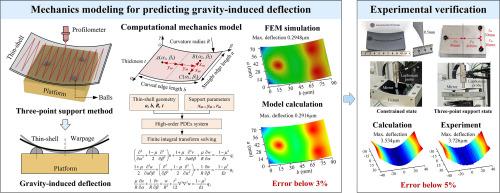三点支承下开口圆柱薄壳重力诱导挠度的解析解
IF 6.6
1区 工程技术
Q1 ENGINEERING, CIVIL
引用次数: 0
摘要
薄壳反射镜是嵌套式x射线聚焦光学系统的基本元件。由于其薄壁结构,这些反射镜在表面形状测量中对重力引起的偏转很敏感。这种不可避免的偏转导致光学表面评估偏差,导致显著的测量不准确性。为了解决这一问题,本研究创新性地提出了一种结合计算补偿的三点支撑策略来减轻重力效应。建立了三点支承下开孔圆柱薄壳重力诱导挠度的解析力学模型。利用二重有限傅里叶积分变换方法,导出了控制挠度函数的精确闭型解,提供了一个适用于随机壳体几何形状、材料特性和支承参数的模型。通过有限元仿真和分析计算对比验证了分析模型的正确性,误差在3%以内。在抛光薄壳反射镜上的实验测量证实了该模型通过从测量轮廓中减去预测挠度来恢复表面真实形状轮廓的有效性。对称支承位置有利于荷载分布,减小薄壳变形。该解析模型为三点支撑下的重力补偿提供了一种高效、通用的计算方法,实现了开式圆柱薄壳结构的高精度曲面形状测量。本文章由计算机程序翻译,如有差异,请以英文原文为准。

Analytical solution for gravity-induced deflection of open cylindrical thin-shell under three-point support
Thin-shell mirrors are essential elements in nested X-ray focusing optics. Due to their thin-walled structure, these mirrors are sensitive to gravity-induced deflection during surface shape metrology. This inevitable deflection resulted in optical surface evaluation deviation, leading to significant measurement inaccuracies. To address this issue, this study innovatively proposes a three-point support strategy combined with computational compensation to mitigate the gravity effects. An analytical mechanical model was developed to predict gravity-induced deflection in open cylindrical thin-shells under three-point support. Using the double finite Fourier integral transform method, the exact closed-form solutions for the governing deflection functions were derived, providing a model applicable to random shell geometries, material properties, and support parameters. The analytical model was validated through finite element simulations and analytical calculations comparisons, showing excellent agreement with errors below 3%. Experimental measurements on the polished thin-shell mirrors confirmed the effectiveness of model in recovering the surface true shape profile by subtracting predicted deflections from measured profiles. It was also found that symmetrical support locations promote favorable load distribution and reduce thin-shell deformation. The proposed analytical model provides an efficient and general computational method for gravity compensation under three-point support, enabling high-accuracy surface shape metrology of open cylindrical thin-shell structures.
求助全文
通过发布文献求助,成功后即可免费获取论文全文。
去求助
来源期刊

Thin-Walled Structures
工程技术-工程:土木
CiteScore
9.60
自引率
20.30%
发文量
801
审稿时长
66 days
期刊介绍:
Thin-walled structures comprises an important and growing proportion of engineering construction with areas of application becoming increasingly diverse, ranging from aircraft, bridges, ships and oil rigs to storage vessels, industrial buildings and warehouses.
Many factors, including cost and weight economy, new materials and processes and the growth of powerful methods of analysis have contributed to this growth, and led to the need for a journal which concentrates specifically on structures in which problems arise due to the thinness of the walls. This field includes cold– formed sections, plate and shell structures, reinforced plastics structures and aluminium structures, and is of importance in many branches of engineering.
The primary criterion for consideration of papers in Thin–Walled Structures is that they must be concerned with thin–walled structures or the basic problems inherent in thin–walled structures. Provided this criterion is satisfied no restriction is placed on the type of construction, material or field of application. Papers on theory, experiment, design, etc., are published and it is expected that many papers will contain aspects of all three.
 求助内容:
求助内容: 应助结果提醒方式:
应助结果提醒方式:


